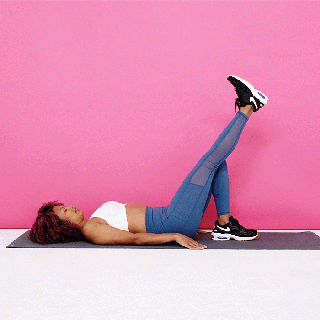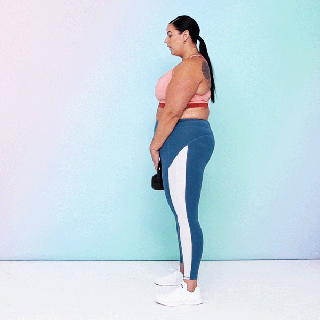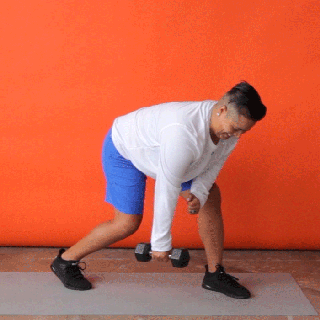6 Exercises You Need to Do If You Sit All Day
Stretch and strengthen where you need it most.
It’s no surprise that sitting in a chair all day is rough on our bodies. While making time to exercise may not totally negate the effects of sitting for hours on end, it can certainly help. Some research suggests that 60 to 75 minutes of moderately intense physical activity a day can counter various effects of sitting—which can include things like increased risk of high blood pressure and blood sugar, abnormal cholesterol levels, and even a higher risk of dying from cardiovascular disease.
Note: It hasn’t been proved that these elevated risks are 100% caused by sitting in particular, but there’s a strong enough association between sitting for long periods of time and negative health outcomes that experts suggest reducing your sedentary time as best as you can. Plus, we know there are some great health effects of exercise and just being active, no matter what that looks like.
At the end of the day (sometimes literally), any movement you can sneak in is better than none.
What sitting all day does to your body
Sitting for long periods of time, especially with poor posture, makes your hip flexors tight, which causes the glutes (butt muscles) to lengthen to compensate. Over time, this compromises the ability of the gluteal muscles to activate properly, leading to a condition called gluteal amnesia, also known as dead butt syndrome. When your glutes can’t do their job, other muscles in your body have to work harder, which ultimately can overwork them, leading to poor body alignment and aches.
Tight hip flexors also make it harder for your pelvis to rotate properly, and inhibited mobility in this area can cause compression and pain in the lower back, physical therapist Dan Giordano, DPT, CSCS, and cofounder of Bespoke Treatments Physical Therapy in New York City, tells SELF.
How to combat the effects of a sedentary lifestyle
If you spend most of your time sitting, there is some good news. While it is true that sitting for most of the day isn’t ideal, there are some ways you can help undo the effects, Noam Tamir, CSCS, founder of TS Fitness in New York City, tells SELF. For starters, Tamir recommends standing up for at least 30 to 40 minutes a day. “A standing desk is also a good option as it will help you become more aware of your posture and engage your core muscles,” he says.
Also, after sitting all day, doing some exercises—especially ones that focus on strengthening the posterior (back) part of your body, like your back, glutes, and hamstrings, while stretching the anterior (front) muscles, such as your hip flexors, pelvis, and chest—can make a huge difference. Doing such moves can help counteract the tightness that ensues when you’re in a seated position, plus strengthen the muscles that we need for good posture.
We asked Tamir to put together a great workout you can do when you’re off the clock to help undo some of the negative effects of sitting all day. “These exercises are designed to strengthen the core, work the posterior muscles of the body, engage the legs, and help with proper pelvic and spinal alignment,” he says. “Together these moves help to offset the imbalances associated with long periods of sitting.”
If you’re itching to work some extra movement after a day full of sitting, try the below routine.
The Workout
What you need: One medium-to-heavy weight, like a kettlebell or dumbbell; an exercise mat
Exercises
- Dead Bug
- Single-Leg Bridge
- Deadlift
- Single-Arm Bent-Over Row
- Goblet Squat
- Plank
Directions
- Do 12–15 reps of the first five moves, and hold the plank for 30 seconds. Rest for 20 seconds in between each move, or more if you feel you need it. Complete three total rounds of this circuit.
#1
Dead Bug
“This exercise focuses on the stabilizer muscles of the core such as the transverse abdominis,” explains Tamir. “So much of posture starts with the core, and this move gives you feedback from the floor” on how to use these muscles properly so your body is aligned.
Lie on your back with your arms at shoulder level raised toward the ceiling. Bring your legs up into tabletop position (knees bent 90 degrees and stacked over your hips).
Slowly extend your right leg straight, while simultaneously dropping your left arm overhead. Keep both a few inches from the ground.
Bring your arm and leg back to the starting position.
Repeat on the other side, extending your left leg and your right arm. That’s 1 rep.
Continue alternating for 12–15 reps.
Dead bugs work the core, specifically, the deepest core abdominal muscles called the transverse abdominis. This is also considered an anti-extension exercise, because your body must resist arching your lower back as you move your arms and legs.
#2
Single-Leg Glute Bridge
“Single-leg bridges are great to help engage the gluteus maximus, the largest glute muscle, plus the core and hamstrings,” says Tamir. Keep these bridges slow and controlled. Focus on really using your glutes to do the movement.
Lie flat on your back. Bend your knees and place your feet flat on the floor about a foot or so away from your butt. Rest your arms at your sides on the floor.
Lift your right leg toward the ceiling, keeping your foot flexed.
Push through your left foot to lift your glutes, hips, and back off the ground.
Slowly lower, keeping your right leg in the air. That’s 1 rep.
Do 12–15 reps, then repeat on the other leg.
The glute bridge is a horizontal hip extension movement that targets your hamstrings and glutes. Making it a single-leg movement adds an extra core stability challenge.
#3
Deadlift
“Deadlifts primarily work the glutes, hamstrings, core, lats, and traps,” says Tamir. Strengthening these posterior muscles helps to reverse the poor posture that tends to befall those of us who sit all day. “When performed correctly, without too much weight and keeping the back in a safe position, deadlifts are one of the most useful exercises to improve posture.”
Stand with a kettlebell or dumbbell (standing up on one of the ends) on the floor between your legs.
Keeping your back flat the entire time, hinge at your hips to push your butt back and bend slightly at the knees to pick up the weight.
Straighten your legs as you pull the weight up to hip level, locking your hips out at the top.
Hinge at the hips again and slowly lower the weight back down until your back is parallel to the floor or the weight taps the floor, whichever comes first. This is 1 rep.
Do 12–15 reps.
The deadlift is a hip hinge movement that targets the glutes and hamstrings. It also works muscles in the core and back.
#4
Single-Arm Bent-Over Row
“With this exercise, you’re working back and shoulder muscles including the rhomboids, traps, lats, and rear deltoids,” explains Tamir. “You’re even working the core because of the bent-over position. A lot of posture flaws can be attributed to an imbalance of strength between the chest and the back, with the chest being more dominant. Rows can help balance that out.”
Hold a weight in your right hand. Stand in a split-stance position, bend your knees, and hinge forward at your hips so that your torso is leaning forward. Rest the other elbow on your front leg.
Keeping your body in this position, row the dumbbell up to chest level, keeping your elbow tight in by your side.
In a controlled motion, lower the dumbbell back to the starting position. That’s 1 rep.
Do 12–15 reps on each arm.
The bent-over row is a pulling exercise that targets the back muscles and shoulder muscles. It also requires core engagement, especially when you’re doing this single-arm version. Make sure to keep your core tight, back flat, and neck in a neutral position (in line with the rest of your spine) to avoid straining any muscles.
#5
Goblet Squat
“This exercise primarily works the glutes, quads, hamstrings, and core muscles,” says Tamir. “When sitting for long periods of time, our hips tend to get tight because they are in a shortened position. Doing squats gets us to sit back in our hips, past the range of motion that we’re used to when sitting at a desk.”
Hold a kettlebell or dumbbell with both hands at your chest. Stand with your feet slightly wider than hip-width apart.
Bend at your knees and hips to lower your butt toward the ground, as if you’re sitting in a chair.
Go as low as you can, then push through your entire foot to stand back up. That’s 1 rep.
Do 12–15 reps.
The goblet squat works the glutes, quads, core, and hamstrings. If your heels tend to pop off the floor as you lower, that’s a sign you need to work on hamstring and ankle mobility. In the meantime, only squat as low as you can go while keeping the heels fully planted on the floor.
#6
Plank
“Here you’re working the full body, especially the core muscles,” says Tamir. “It’s important to focus on having good pelvic alignment and not rounding the back.” Planks can help to both strengthen the core and improve pelvic orientation.
Start on your hands and knees. Your hands should be shoulder-width apart; your knees should be about hip-width apart.
Lift your knees off the ground and step your feet back so that your legs are straight and fully extended.
Keep your core, butt, and quads tight, and avoid arching your back. Think length—imagine that you’re extending out from the crown of your head and out through your heels simultaneously.
Keep your neck in a neutral position by gazing at the floor a few inches in front of your hands.
Hold for 30 seconds.
The plank is an isometric exercise that targets the entire core, plus the shoulders, triceps, and upper back. If you can’t hold a plank for 30 seconds without breaking proper form, start with 10 or 15 seconds and work your way up. If 30 doesn’t feel challenging for you, try holding for 45 seconds or a minute.





.jpg)